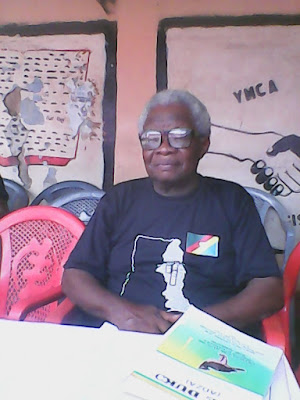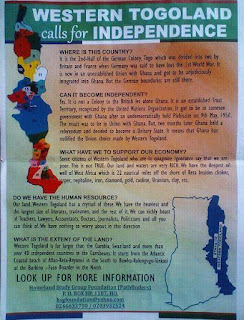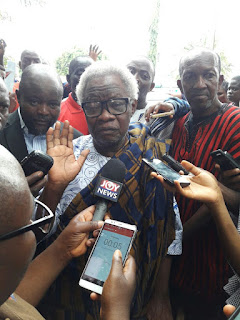Seekers of Independent, (Western Togolanders)
THE 1956 TRANS-VOLTA TOGOLAND
PLEBISCITE AND MATTERS ARISING
1. Introduction
On 17 August 2016, my attention was
drawn to a news article published in the Daily Graphic, which inter alia,
mentioned a group known as The Homeland Study Group Foundation (HSGF) based in
Ho in the Volta Region of Ghana “agitating for the restoration of so called
Western Togoland as a state to declare independence for Western Togoland on 9
May 2017.”[1] According to the leader of the group, “…. the Western Togoland
were plebiscite citizens in Ghana and not until a declaration was made on 9 May
2017, the people will remain an appendix to the former Gold Coast (now Ghana). They
also claimed that “...world historical documents had revealed that Western
Togoland was a state and not a territory of Ghana.”
Fundamentally, HSGF claims that
although residents of the Western Togoland voted in 1956 to become a union with
the Gold Coast (now Ghana), the union has not been formally established by way
of a unionized constitution to date.[2] That is, Queen Elisabeth II did not
incorporate Western (British) Togoland in the Act establishing the Gold Coast
(now Ghana). Thus, they claim they are right in calling for a secession to form
a new sovereign state.
However, do these arguments really
stack up against the historical record? The purpose of this article is to
analyse the recent calls by the HSGF in light of the existing historical
narrative to address the following: (1) the history of Western Togoland (2)
political associations in the Togoland (Unificationists vs Unionists) and (3)
the plebiscite and matters arising.
 |
| Charles Kormi Kudzordji (Papavi Hogbedetor) |
2. History and Makeup of Western
Togoland Africa's international boundaries
were delimited and subsequently demarcated by European States following the
1884 Berlin Conference (Prescott, 1963; p1). The division of the former German
colonies of Togoland, Kamerun (now Cameroun) and Tanganyika (Great Lakes
Region) into British, French and Belgian Mandates after World War I was one of
the most important boundary changes that took place.[3]
Prescott (1963) notes that before
the European intervention “the Ewes were politically divided into about 120
subtribes lying between the centralised military kingdoms of Abomey and
Ashanti. During periods of war temporary alliances were formed amongst the Ewe
groups, but these were dissolved in times of peace.”[4] The Anglo-German
boundary, which lay between Lomé and the Volta River divided Eweland into two
protectorates namely British Gold Coast Colony and German Togoland. The British
administered their mandate as an integral part of the Gold Coast Colony whereas
the French kept theirs administratively separate from Dahomey (Benin) and Upper
Volta (Burkina Faso). Both Togoland under the British protectorate and Togoland
under the French protectorate were under supervision of the Trusteeship Council
of the League of Nations (now the United Nations).[5] The Ewe area in the
British controlled territory was formally constituted into the
Trans-Volta-Togoland region in 1952 to enable effective administration as a
single group (Prescott, 1963; p5). The landmass of British Togoland stretches
from Bawku East district in the Upper East region and borders the Volta River
up to the Gulf of Guinea.
Bening (1983) notes that the
original boundary between the British colony of the Gold Coast and protectorate
of Togo included not only the Ewe of the Keta and Peki districts in territory
but it also divided the Mamprusi, Dagomba and Gonja states as well. The
division of Togoland exacerbated the so-called “Ewe Problem - that is to say
Ewes, who hitherto saw themselves as a “nation state”, were politically divided
into two administrative camps with different official languages. The movement
for Ewe unification in southern Togoland was particularly inspired along
socio-economic, social-political, and cultural factors. The so-called “Ewe
problem” bedevilled the UN for a decade from 1946 to 1956 and was concerned
with the objectives of nationalists who wanted not just “national home, but a
homeland-state, with a flag, a leader, a national anthem, a capital, embassies
abroad, representation at the United Nations, and an independent voice at
Pan-African meetings”
Interestingly, the records show that
“there was no Ewe state in precolonial times, although there were several
semi-autonomous Ewes-peaking communities along the coast and in the Togo
hills.”[6] Amenumey, however, asserts that what they wanted was “not an
autonomous Ewe state but rather the grouping of the Ewe together within a
larger unit of the two trust Territories and the Gold Coast' (Amenumey 1989:
p44-45). The Dagomba’s under the Northern Territories Territorial Council also
supported the Ewe position that the partition had created problems for them to
the extent that “the Ya Na could not exercise his full authority in Western
Dagomba (Bening, 1983; p204)”
3. Political Associations in
Togoland (Unificationists vs Unionists)
The 1950s saw a rise in Pan-tribal
movements amongst groups that had hitherto been divided by colonial boundaries.
They now saw political advantage and security in being united on one side of
the boundary (Prescott, 1963; p3). For example, there were constant demands by
some Ewes for unification either as a separate or to join Ghana or Togo
Republic.[7] Two key groups emerged Post World War II on the status of
Togoland: the unificationists and the unionists. The unificationists held on to
the idea of a pan-Ewe nation state encompassing both French and British
Togoland whereas the unionists held on to the belief that their interests will
be best served under the Crown. A popular claim of the unificationists against
the unionists was that “far from being free, the Ewes will be dominated by
other Gold Coast peoples if integration takes place” thus taking a similar
position as the National Liberation Movement of Ashanti.[8]
The proponents from the opposing
camps of the debate were the Convention Peoples' Party who were for integration
with the Gold Coast (Unionists) and the Togoland Congress who were for
unification of both French and English Togolands.[9] The leader of the Togoland
Congress was a man named George Antor who was a keen advocate for the
unification not only of the Ewes but of both Togolands.[10] It is reported that
“… a deal was made between Antor and Olympio (from French Togoland) that
unification of Togoland would come first with a promise to associate in some
form with the Gold Coast so that a maximum number of Ewes could come together.”[11]
However, with the advent of
independence in the Gold Coast, “some of the Ewe leaders including Daniel
Chapman and Gerald Awumah expressed the view that the best hope for the Ewe
people lay in the integration of British Togoland with the Gold Coast.” Despite
the pro-unification Togoland congress claiming to be acting on behalf of all,
the historical records show that it really spoke only on behalf of only the
Ewes in the South - i.e. between Ho and Keta. The Africa Today report of 1957
mentions splits in the ranks of the unificationists. They noted “the Togoland
Congress claims to stand for the unification of all Togoland as though this
area were a natural entity. Other unificationists say let the north and center
go to the Gold Coast if they wish but the south (Ewe Territory) must remain as
a Trust territory so that the door may be left open for the uniting of the Ewe
nation.”
4. The Plebiscite and Matters
Arising
In 1954, a United Nations Visiting
Team to British Togoland recommended a plebiscite to be held to decide on the
wishes of the Togoland people on the issues of whether the Trust Territory
should be integrated into or secede from the Gold Coast. The plebiscite came
about because the British government, having granted internal self-government
to the Gold Coast in 1954, informed the UN it could no longer administer
British Togoland separately after the Gold Coast had achieved full independence
(Bening, 1983; p205). The future of the Togoland territory was decided based on
majority votes of the plebiscite from these four areas: (1) Northern Section of
British Togoland, (3) Kpandu and Ho Districts; (3) Buem-Krachi District north
of the southern boundary; and (4) Buem-Krachi District.[12]
On 9 May 1956, the poll was held
with an 83% voter turnout estimated at 160,587 persons. A resounding 58% of the
population backed the union with the Gold Coast with the remaining 42% voting
against it. The same plebiscite in French Togoland, showed a majority of the
people voting in favour of the territory becoming an autonomous republic within
the French Union (Prescott, 1963). Interestingly, the results showed that there
was an overwhelming support for the union in the Northern Togoland region
whereas the Ewe-speaking areas of the south namely in Ho and Kpando voted
strongly in favour of seceding from the new Ghana. To put this into context, Ho
and Kpando regions comprised only about 15% of the territory in terms of
landmass.[13]
On this basis, the British
government therefore recommended that the Trans Volta Togoland should be
integrated into the Gold Coast. This suggestion, however, did not go down well
with a portion of those from the Ewe speaking regions as they had opted to join
the French Togo in the plebiscite which had then attained the status of an
autonomous republic. There was even an armed rebellion by the people of
Alavanyo against integration with the Gold Coast.[14]
Figure 1 Results of the 1956
Plebiscite in British Togoland
Source: UN Year Book (1959) cited in
Bening (1983)
Following the recommendation by the
British government on the basis of the poll results, the Fourth Committee of
the Eleventh Session of the General Assembly of the UN approved the union “….
and their recommendation was adopted by the General Assembly and on 6 March,
1957 the British trust territory of Togoland and the Gold Coast became the
independent and unitary state of Ghana.”[15] The new Parliament of Ghana after
independence adopted the UN resolution to merge and integrate the Trans-Volta
Togoland with Ghana which was then given the name Volta Region.
5. Conclusions
From the above historical
exposition, it is trite to say the requisite protocols were followed in the
run-up to Trans-Volta Togoland becoming part of the unitary state called Ghana.
It is highly fatuous for anybody to claim that they have the right to secede
because the Trans-Volta Togoland-Ghana union has not been formally established
by way of a unionized constitution to date. The processes adopted and the
results of the plebiscite were clear: the vote was not for federal union!
Rather, it was to join a new unitary state called Ghana. The Queen did not need
to incorporate Western (British) Togoland into an Act establishing Ghana - i.e.
the 1956 Ghana Independence Bill.[16]
This issue of secession did not
start today. Indeed, some people publicly demanded secession from Ghana at a
1975 durbar attended by Gen. I.K. Acheampong at Ho. The historical records even
show that a legion of Ewe chiefs also went to Lomé and petitioned the Ghana
Ambassador there to initiate immediate negotiations between the two countries
for a solution to the demands for the reunification of Togoland. Finally, let
me restate here again that the May 1956 plebiscite duly prepared the way for
British Togoland to join the Gold Coast and became a fully independent state of
Ghana on 6 March 1957. The interests of elements in this fringe secessionist
group should be discounted and treated with the contempt it deserves. I have
not seen any 50 year expiry date on the plebiscite.
Published by Patrick Setordzi Yahesu.
24th April, 2017.






Comments
Post a Comment